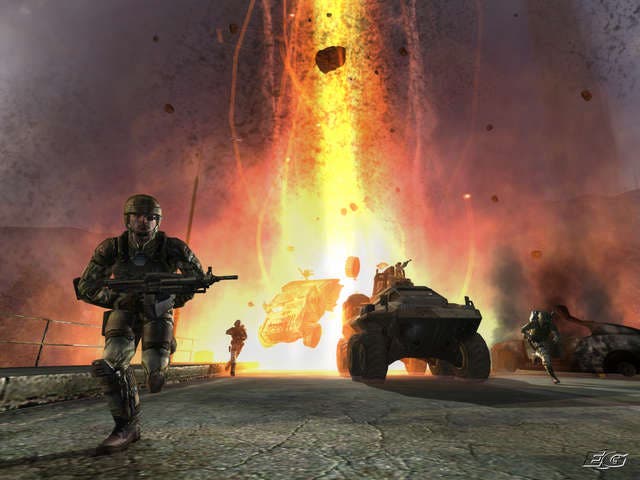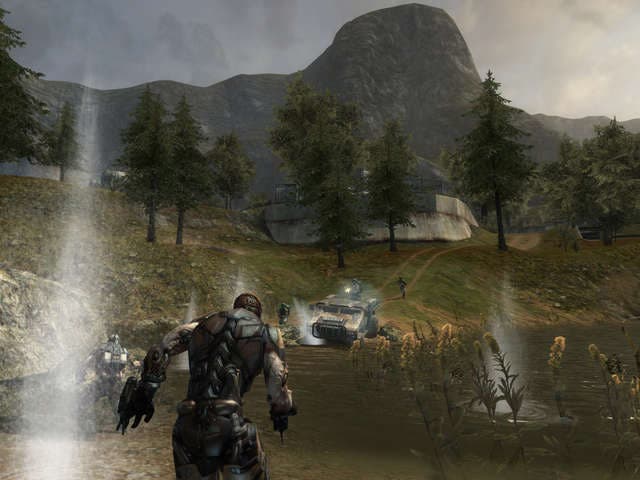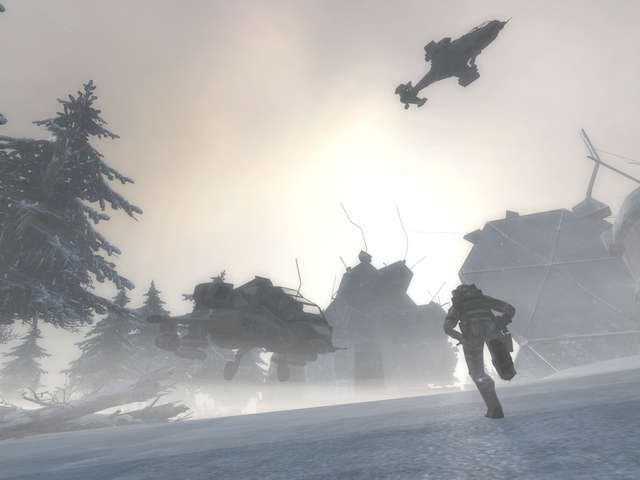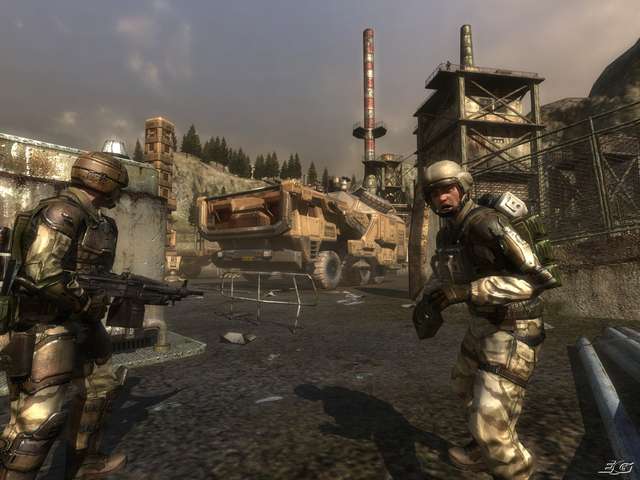Enemy Territory: Quake Wars
Paul Wedgwood on what makes it tick. And boom.
From installing servers to leading the development of one of the most hotly anticipated games around, Paul Wedgwood's rise to power borders on the meteoric. After an adrenaline-fuelled day spent playtesting the latest build of Quake Wars and eating delicious sandwiches it became clear we were dealing with something special. The game, not the sandwiches. Although they were pretty special. We sat down with Paul ('Loki' to use his clan name) to pick his brain about how he's boldly lead his studio to what looks to be another success.
Well, when we started on Wolfenstein: Enemy Territory we had this whole bunch of ideas that were left over from Return to Castle Wolfenstein when Id Software worked with Nerve Software. And that kind of spawned the high concept for Wolfenstein: Enemy Territory. When we started Enemy Territory: Quake Wars the initial impetus was a similar thing. Kevin Cloud is co-owner of Id Software and executive producer of the project and creative director. That's one of the reasons I use the title lead game designer not creative director because I kind of see him as my boss. Anyway, so with me and him as co-owners of Splash Damage it's kind of like having a couple of 15 year-olds in the office going 'Wouldn't it be cool if you could do this? Wouldn't it be cool if you could do that?!' And again, leftover notes from Wolfenstein have contributed.
Really the first goal is to evolve the gameplay of Wolfenstein Enemy Territory. We knew the focus on objective oriented combat and the option of playing a character class that suited your preferred playing style were really popular ideas. People really enjoyed that. So what we wanted to do was situate that in the Quake universe and give it a more futuristic setting, allowing us to have these asymmetrical teams. Now we've got the GDF with their conventional military weapons and the Strogg with their advanced alien technology.

It's obviously a challenge. In Wolfenstein Enemy Territory we used a formula called Damage Over Time. We'd just take a weapon and multiply how many rounds it fired in a minute by the damage each bullet caused, then make sure two opposing guns just came up with the same number. So in that sense the teams on Wolfenstein were just reskinned versions of one another with different audio quotes.
In Quake Wars there's no simple way of balancing, say, a Strogg flyer drone with a GDF camera, or the Strogg spawn ability with the GDF's ability to call in supply drops. So we took a kind of heuristic approach that basically involved lots and lots of arguing and tons and tons of playtesting. Literally just thousands and thousands of hours of playtesting with our production and development teams at Splash Damage, the QA team at Activision and Id Software's playtesting team as well. Then just discussing every item and ensuring it has a counter and that it's not overpowered, then ensuring the counter is balanced and not overpowered, then ensuring the counter to that is balanced in this kind of rock-paper-scissors fashion.
Well we had a really good writer, Ed Stern, who's a senior designer here at Splash Damage, and he started writing the back-story with Kevin Cloud. So there were two kind of processes to game design. Sometimes they'd come up with things the Strogg should have and sometimes we wanted what we knew would be fun, like the Goliath Heavy Walker. Then Ed would have to write how it came about and that back-story would drive the initial content. Sometimes we'd get that right first time. With the Walker I think we went through three in-game complete re-workings of it, and I think eight or nine concepts? And for the Strogg character models we went through about fifty different concepts.

Yeah. Well there were two things we discovered with the Walker because of our fairly realistic physics system which approximates articulated suspension, propulsion and steering and isn't just a rigid box moving over a smooth landscape. Like with the Trojan six-wheeled APC we discovered it needed four-wheel drive because the design meant it wouldn't be able to turn otherwise. And our first shot at the Walker suffered because it had too cyclic a walking pattern and had trouble making it up hills and stuff. So we had to come up with something that had a bit more suspension and more IK [inverse kinematics? - EG] on the toes and stuff which would be able to deal with more complex landscape.
So there were two reasons generally that we'd revise something. Either it just wouldn't work in the physics system and we had to restructure the model to something more realistic, or artistically something just wasn't working out. Like we did a lot of weapon concepts that looked great on paper but once you got them into first-person, due to the nature of foreshortening they just looked terrible or didn't texture the way you wanted them to. So there were lots of assets in the game that got stripped out and replaced to make sure they worked.
Ooh. That's a difficult question... I would say that the fire support is one of the big 'Wow' moments of the game. When you call in a Strategic Strike Gun it takes longer than the other weapons to be delivered and then it just tears through the atmosphere and crashes into the ground, and you can look at this big gun and just know that it's yours and you're the one who's going to be firing it. Now obviously there's a reload time and conditions for firing it but when you do launch it it's just this massive, ectoplasmic blue orb... it's actually a bosonic orb. We were talking about back-story - we have people who go off and write about how gravitonic propulsion works, or why bosonic orbs are something that the Strogg would use. And we have these defining types of technology found everywhere in the Strogg design.

In the case of the Strategic Strike Gun the result is this kind of arcing ball but it's kind of slow flying, and everybody who hears it just looks up. It has this impressive presence, you know? It's kind of like the Strogg nuke.
There are two sides to that. Firstly we're trying to improve knowing how and why death and incapacitation occurs, but it's a difficult thing. I mean a vehicle can run you over even though there's no player in it. You can be hit by ordnance from the sky even though the Field Ops player up on the hill is the one that targeted you, and it's not that intuitive for a player to look up to the hill when they just got hit by artillery from a different direction. So they're just general design challenges we're working out.
The other side is that we want players to think about how they're going to avoid their death next time. The first time you run down the middle of the road and get shot you think 'Okay, next time I'll use cover.' Then the first time you're shooting someone and they easily spot you and shoot back, you think 'Okay. Maybe I need to think about concealing myself.' And when you've got a big vehicle like a tank or whatever and you roll out into the middle of the road and everthing beats on you, then you notice there's a fortification by the side of the road so if you just reverse in a bit you might be totally covered except for your turret. So there are always these methods you could apply to avoid the same death twice.
Pretty good! I mean I started as a kind of Id fanboy back in the '90s. By around '97 I started playing Quake 1 obsessively online with a clan and until I started working on Quake 3 Fortress I just read obsessively about everything Id did and said.

Yeah! Definitely. One of my best friends at Id Software now is a guy called Robert Duffy who was the lead programmer on Doom 3. He was recruited from the community as the guy who wrote the original Radiant, the level editor. So the idea that this guy wrote the level editor by himself and Id Software later made him the lead programmer on Doom 3 is such a cool thing.
And when you think about it, I was just some IT bod installing servers in soulless comms room, ordering equipment that I knew wouldn't even exist for three years time. In terms of having the least creative job on the planet that's certainly up there. And now five years later I'm the owner of a games developer working on a triple-A title as lead games designer, and that's a pretty cool transition. And really I owe all of that to Id Software.
Well, the company porting Quake Wars is Nerve Software. They're the guys who developed Return to Castle Wolfenstein: Tides of War and Resurrection of Evil for the Xbox. They've got experience working on online games and Xbox games, so they're definitely the right company.
Id Software have a 'plan'. So they're definitely supporting it. Our primary focus is to get the software development kit out there, the source code, wiki documentation and stuff. Getting together all the artistic assets we used for the creation of the megatextures, getting all that out there. Making sure the community are capable of level design. Then we'll start thinking about additional content.
No.

I think chaos provides you with player immersion and order is the thing that makes the gameplay work. So playing as an organised team makes for the most satisfying experience in terms of multiplayer combat, that's the thing that gives you the real buzz. But the feeling of being in a war, what seems like complete chaos with all these explosions going off, vehicles falling off the edge of cliffs and rockets flying past you and stuff, that's the chaos side and that's what makes you feel immersed.
Exactly! And actually you know war looks pretty chaotic but at the base of it, in a server with twenty-four people who know exactly what they're doing, you're still going to have rockets flying past you.


